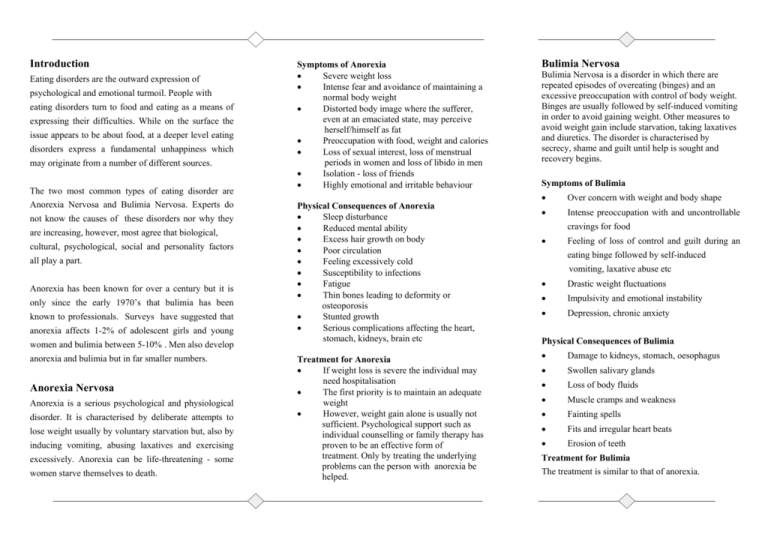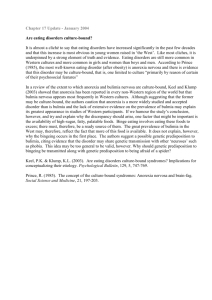Eating Disorders
advertisement

Introduction Eating disorders are the outward expression of psychological and emotional turmoil. People with eating disorders turn to food and eating as a means of expressing their difficulties. While on the surface the issue appears to be about food, at a deeper level eating disorders express a fundamental unhappiness which may originate from a number of different sources. The two most common types of eating disorder are Anorexia Nervosa and Bulimia Nervosa. Experts do not know the causes of these disorders nor why they are increasing, however, most agree that biological, cultural, psychological, social and personality factors all play a part. Anorexia has been known for over a century but it is only since the early 1970’s that bulimia has been known to professionals. Surveys have suggested that anorexia affects 1-2% of adolescent girls and young women and bulimia between 5-10% . Men also develop anorexia and bulimia but in far smaller numbers. Anorexia Nervosa Anorexia is a serious psychological and physiological disorder. It is characterised by deliberate attempts to lose weight usually by voluntary starvation but, also by inducing vomiting, abusing laxatives and exercising excessively. Anorexia can be life-threatening - some women starve themselves to death. Symptoms of Anorexia Severe weight loss Intense fear and avoidance of maintaining a normal body weight Distorted body image where the sufferer, even at an emaciated state, may perceive herself/himself as fat Preoccupation with food, weight and calories Loss of sexual interest, loss of menstrual periods in women and loss of libido in men Isolation - loss of friends Highly emotional and irritable behaviour Physical Consequences of Anorexia Sleep disturbance Reduced mental ability Excess hair growth on body Poor circulation Feeling excessively cold Susceptibility to infections Fatigue Thin bones leading to deformity or osteoporosis Stunted growth Serious complications affecting the heart, stomach, kidneys, brain etc Treatment for Anorexia If weight loss is severe the individual may need hospitalisation The first priority is to maintain an adequate weight However, weight gain alone is usually not sufficient. Psychological support such as individual counselling or family therapy has proven to be an effective form of treatment. Only by treating the underlying problems can the person with anorexia be helped. Bulimia Nervosa Bulimia Nervosa is a disorder in which there are repeated episodes of overeating (binges) and an excessive preoccupation with control of body weight. Binges are usually followed by self-induced vomiting in order to avoid gaining weight. Other measures to avoid weight gain include starvation, taking laxatives and diuretics. The disorder is characterised by secrecy, shame and guilt until help is sought and recovery begins. Symptoms of Bulimia Over concern with weight and body shape Intense preoccupation with and uncontrollable cravings for food Feeling of loss of control and guilt during an eating binge followed by self-induced vomiting, laxative abuse etc Drastic weight fluctuations Impulsivity and emotional instability Depression, chronic anxiety Physical Consequences of Bulimia Damage to kidneys, stomach, oesophagus Swollen salivary glands Loss of body fluids Muscle cramps and weakness Fainting spells Fits and irregular heart beats Erosion of teeth Treatment for Bulimia The treatment is similar to that of anorexia. In Summary The sooner one begins treatment for an eating disorder, Where to find Help treatment is not always easy. So an important first step Student Counselling Service Room 010 on the ground floor of the main building. Left after the yellow staircase on the main corridor and left again. Tel: ext 2635 (from outside 4042635) in overcoming an eating disorder is for the person to E-mail: aisling.obrien@it-tallaght.ie the better the outcome is likely to be. Unfortunately, convincing those with eating disorders that they need Eating Disorders acknowledge to yourself and to helping professionals that an eating disorder is a problem. If you have an eating disorder seek professional help now! Student Health Centre: Room 110. off first floor corridor of the main college building. Extension 2613. E-mail: orlagh.fleming@ittdublin.ie As mentioned above all eating disorders are symptomatic of emotional, psychological, personality, social and cultural issues. In one-to-one counselling a person can explore and learn to understand the Your GP Bodywhys Helpline (Tel: 01-2835126) underlying issues in a safe, confidential environment thus breaking the experience of isolation. An individual Some Reading can gain new coping strategies conquering the driven There is quite a lot of literature on eating disorders in most large book shops. Below are some books available in the College Library obsession with food and body image that seems to override all life’s activities. Recovery is not immediate. In some ways, it is ongoing. People with eating disorders may need to repeatedly face and struggle with the same issues again and again in order to achieve any resolution. However, what is Eating Disorders: the facts - Suzanne Abraham (1997) When food becomes your enemy: anorexia nervosa, bulimia nervosa and comfort eating - Gillian Moore-Groake (1996) important to remember is that recovery is possible. Eating your heart out: understanding and overcoming eating disorders - Julia Buckroyd (1996) Student Counselling Service Anorexia and Bulimia: your questions answered - Julia Buckroyd (1996) Institute of Technology, Tallaght Student Services






